December 12, 2014
Air Date: December 12, 2014
FULL SHOW
SEGMENTS
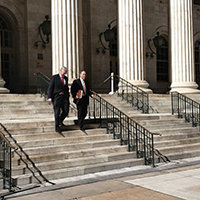
Republican AGs Fight Environmental Regulations
View the page for this story
State Attorneys General didn’t used to be big players in national policy-making, but that’s changed in recent years. Now Republican AGs allied with fossil fuel companies are challenging federal environmental regulations in court. Marquette University political scientist Paul Nolette discusses this development with host Steve Curwood and explains why it raises concerns about conflicts of interest, democratic process and protection for the environment. (13:35)
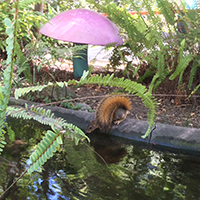
An Amusement Park’s Unruly Squirrels
/ Meaghan BausView the page for this story
Cute fox squirrels in California’s Fairyland amusement park aren’t playing nicely, but rather wreaking havoc by stealing food and chewing up water lines. Park managers are not amused, and they are turning to animal control scientists to rein in the aggressive squirrels and return harmony to Fairyland. Youth Radio’s Meaghan Baus reports. (05:00)
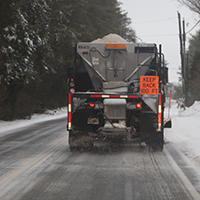
Icy Roads Prescribed a Low-Sodium Diet
/ Jenni DoeringView the page for this story
Road salt helps to melt ice and keep travelers safe but too much can harm the environment and wildlife. Living on Earth’s Jenni Doering reports that scientists are testing unusual salt alternatives including waste products from sugar beets, barley and cheese to cut the salt and keep roads clear. (02:00)
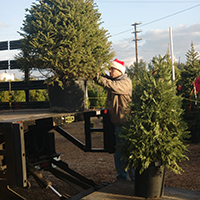
Renting Trees Keeps the Christmas Spirit Alive
View the page for this story
For Scott Martin, the joy of Christmas was spoiled by the sight of discarded trees in the trash in the New Year, so he founded a company that rents living Christmas trees. His alter ego “Scotty Claus” tells host Steve Curwood why renting a living tree is better for the environment and how it captures the spirit of the season. (10:10)
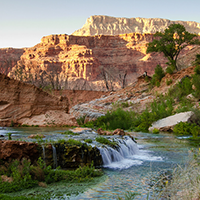
Beyond the Headlines
/ Peter DykstraView the page for this story
In this week’s trip beyond the headlines, Peter Dykstra tells host Steve Curwood about the successes of a giant defender of rivers, a clever scheme to expose predatory science journals, and the possible environmental connection between the Unabomber and his targets. (04:50)
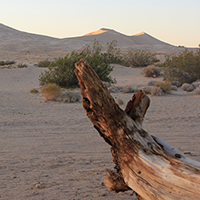
Quiet Places Around the World
View the page for this story
Trevor Cox, a professor of acoustic engineering at the University of Salford in the UK, explores the world looking for its most interesting sounds and wrote about them in The Sound Book. But he also considers silence and tells host Steve Curwood about the uncomfortable effect of a totally dead room, the natural silence of the Mojave desert and the importance of preserving quiet places to our well-being. (12:35)
Show Credits and Funders
Show Transcript
HOST: Steve Curwood
GUESTS: Paul Nolette, Scott Martin (Scotty Claus), Trevor Cox
REPORTERS: Meaghan Baus, Jenni Doering, Peter Dykstra
[THEME]
CURWOOD: From Public Radio International, this is Living on Earth.
[THEME]
CURWOOD: I'm Steve Curwood. A new wave of legislation by litigation, as GOP state Attorneys General ally with fossil fuel interests to fight EPA regulations.
NOLETTE: A couple of years ago, Greg Abbot of Texas described his role as AG as “I wake up, I sue the Obama Administration, I go home,” and I think that that’s been a pretty accurate encapsulation of what’s going on.
CURWOOD: Also, ’tis the season for bringing sweet smelling evergreens into homes, but that joy of the season can have a sad ending.
MARTIN: Everybody's happy to see you. The problem was that intense joy that you felt was sort of curbed when a couple weeks later I’d see that same tree that I struggled to get to the second storey of this person's house thrown out like the trash ... and I thought, “why can't we do this with living trees?"
CURWOOD: And now you can rent a living tree. That and more this week on Living on Earth. Stick around.
[NEWSBREAK MUSIC: Boards Of Canada “Zoetrope” from “In A Beautiful Place Out In The Country” (Warp Records 2000)]
ANNOUNCER: Support for Living on Earth comes from United Technologies – innovating to make the world a better, more sustainable, place to live.
Republican AGs Fight Environmental Regulations
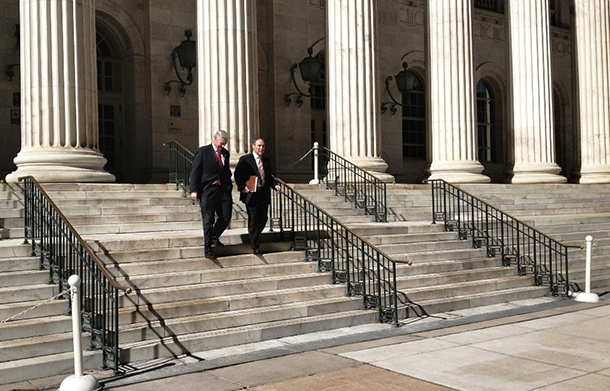
Oklahoma Attorney General Scott Pruitt has been particularly active suing in federal government over environmental regulations (Photo: ok.gov)
CURWOOD: From the Jennifer and Ted Stanley Studios in Boston and PRI, this is Living on Earth. I’m Steve Curwood. According to the US Constitution, Congress makes the laws, the President implements them and the Supreme Court rules on violations and disputes. But with Congress and the Presidency stuck in gridlock, more and more the courts are forced to re-interpret old laws to address new challenges.
There’s been no major national environmental legislation passed since 1990, and litigation is taking over, with state attorneys general playing a powerful role. When the Bush Administration failed to address global warming, in 2005 the Attorneys General of 12 states, led by Democrats in Massachusetts along with environmental groups, sued and won. The Supreme Court ordered the EPA to regulate non-toxic CO2 as a pollutant, based on the Clean Air Act of 1970, which was largely aimed at poisonous smog. Now, key Republican AGs are joining forces with the fossil fuel industry to roll back some Obama administration regulations, especially regarding power plant emissions. Copious campaign contributions from this industry prompted a recent story in the New York Times that raises questions of conflicts of interest.
Paul Nolette is a lawyer who teaches political science at Marquette University and the author of a forthcoming book called “Federalism on Trial: State Attorneys General and National Policy Making in Contemporary America”.
NOLETTE: Republican AGs in general, but particularly led by Oklahoma’s Scott Pruitt and Texas's Greg Abbott, have brought numerous lawsuits to challenge individual pieces of the Obama Administration’s EPA regulatory program. Virtually all environmental rules, whether they deal with climate change, or mercury, or a variety of other issues, water pollution, AGs have been there, and they have challenged the Obama administration. I don't know exactly what Greg Abbott in Texas, what his count is up to, but I know it's well into the dozens in terms of the number of lawsuits that he's brought to challenge the Obama administration. A couple years ago, he described his role as AG as, "I wake up. I sue the Obama administration. I go home," and I think that that's been a pretty accurate encapsulation of what's going on.

Republican AGs are challenging the EPA’s regulations on emissions from coal power plants. (Photo: Bigstockphoto)
CURWOOD: Now, remind us about the traditional role of the state attorney general.
NOLETTE: So, traditionally AG's really focused much more on the state level. They would perhaps most commonly be defending the state against lawsuits brought against it. But what's happened and what's changed over the last couple decades in particular and escalating even more so in the last few years, is that AGs have gone beyond this traditional role and been much more aggressive in going on the offense in bringing lawsuits, both against corporations and against the federal government.
CURWOOD: Now, in terms of the environment, as I understand it, attorneys general got really involved in a case known as Massachusetts versus EPA, the litigation that wound up in the Supreme Court saying, yes, the EPA can regulate CO2, the global warming gas, as a pollutant, and it's, of course, the force behind the current fight over regulating power plants.
NOLETTE: Yes, that's exactly correct. Massachusetts v. EPA, not only was it perhaps the most important case in environmental law, it really marked a crucial victory for the AGs that has sparked a backlash among anti-regulatory forces. And so a lot of what you see with Republican AGs bringing lawsuits against the Obama administration, not all of them, but many of that has come about because of fallout from Massachusetts v. EPA in the new climate rules from the Obama administration.
CURWOOD: Interestingly, the Massachusetts v. EPA case joined state attorneys general with environmental organizations like NRDC, the Sierra Club, and such. Today, we're talking about conservative Republican attorneys general joining with energy producers who have an interest in the regulation. What's the difference here in your view?
NOLETTE: Well, I think one way of looking at it is to say that it's really the the other side of the same coin. During the George W. Bush administration, when the EPA was essentially not taking the actions it needed on climate change and other issues, Democratic AG's took full advantage of that, and as you mentioned, allied with various interest groups like the Sierra Club to bring lawsuits. And so what we see now is Republicans saying, if you're going to play at that game, so are we, and with others with interests in blocking the types of regulations that the Obama administration has been promulgating.
Now that being said, I do think these industry AG relationships do raise an additional issue, and a problematic one, in that many of these industries have also been big-time campaign donors to AGs and so it raises the prospect at least of a sort of quid pro quo going on here in terms of, "Hey, if you send in these donations, then that's going to affect my enforcement strategy". And that is quite problematic.

Republican AGs are challenging water pollution rules in court as well. (Photo: Bigstockphoto)
CURWOOD: So how much fossil fuel money in particular is influencing of these attorneys general elections do you think?
NOLETTE: Well, it's hard to say because a lot of it is dark money where it's hard to know precise figures about how much money is in the system, how much is going to party organizations like the Republican AG organization or the Democrats, and also it's difficult to know who the actual funders are. I mean, what I can say is that it we're talking millions of dollars, whereas before AG offices were really considered pretty sleepy positions on the state level that a lot of people ignored including lobbyists, but that's certainly not the case anymore.
CURWOOD: Remind us why an attorney general being in a case gives added leverage to say a private interest, an energy company.
NOLETTE: Well, it's interesting. One of the big holdings in Massachusetts v. EPA beyond its importance for climate change specifically was that it announced a new standard to get into court for states. As the court put it, states should be offered special solicitude when the court is analyzing whether they have a claim that they can press in court. And so what that means, the bottom line is, that states probably have an easier time getting to court than a lot of industry groups, so allying with the states makes it easier to get into court. It also helps to bring a greater level of legitimacy to lawsuits, I think. You know, if it's Corporation A bringing a lawsuit against the Obama administration, it's easier to dismiss that and, say, well they're just suing in their self-interest or something. But by bringing in AGs into the process, you can say, oh, we have this coalition of 20 some odd states and this is really about fundamental constitutional issues like federalism. And so it brings a certain level of legitimacy that might not be there if was just a industry-only suit.
CURWOOD: So, how important is the Supreme Court case allowing corporations to make pretty much unlimited donations to politicians, a case called Citizens United. How important is that to this most recent development?
NOLETTE: It's important. It's very important actually, because a lot of these donations that are going to, say, the Republican or Democratic AG organizations are unlimited in nature, are dark money, so it's hard to know, it's been really impossible to know where the money is actually coming from, and the Citizens United campaign finance regime has helped allow that to happen. I think a lot of the emphasis at first, and a lot of the analysis of Citizens United and campaign finance, has been focused on the federal level and the impact there, but I think you see with state AGs that the impact really does trickle down to the state level very much so, and again, money is going to flow where the power is and as AGs get more power they're also seeing more money flow in terms of lobbying donations.
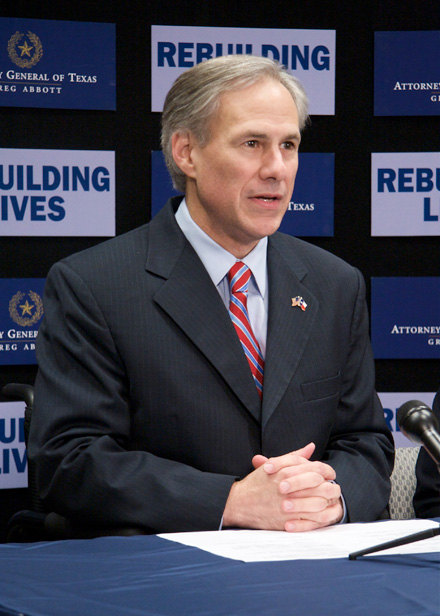
Texas Attorney General Greg Abbot has sued the Obama administration over 30 times. (Photo: www.texasattorneygeneral.gov)
CURWOOD: Understanding that it's hard to trace where contributions come from, in your view, which side do you think is getting more money? The more liberal, often more Democratic side or the more conservative, usually Republican side?
NOLETTE: I think right now the Republican side is getting more money. Their national organization, the Republican AG Association, has been a lot more active in trying to get Republicans elected, in negotiating which way that Republican AG should go in terms of policymaking and also raising money.
CURWOOD: To what extent do you think the situation now is that if these attorneys general are getting significant contributions from these industries that actually they're acting in their own personal self-interest when they go into court with these companies as well as ostensibly for the citizens in their state.
NOLETTE: Right, I mean I don't want to speculate too much and say, “oh there's certainly a big link between the money coming in and the AG actions that are going out”, but it certainly raises some real questions, and I think one of my big concerns is that so much of this has been completely under the radar. You know, I think the New York Times story really helped to bring out some of the issues that are going on, but a lot of these collaborations are simply not in public at all. And so it's hard to know how much of an impact this money and this lobbying is having.
CURWOOD: For many years we've had a fairly dysfunctional Congress. To what extent is this coalition of attorneys general pushing back on federal regulation, stepping into a void that’s been left by the ability to get legislation through on Capitol Hill?
NOLETTE: I think you have your finger right on it. Given the fact that there's been a long history in the last several years of mostly divided government, all throughout American history when you see those sorts of dynamics happening on the federal level, a lot of policies been pushed to the states. So that particular aspect of it isn't a new development, that's something that's been true in American federalism for quite some time. But what is new is that state AGs are playing the major national role that they are now. So I think you're exactly right to say that the dysfunction, and I think it's fair to call it a dysfunction on the federal level, is one of the major reasons why AGs have been able to step up and say, “well if Congress isn't going to do it, we are”.
CURWOOD: How healthy for our democracy is this development, and if you think it's not so healthy, how would you unwind it?
NOLETTE: It's a good question, and it's a big one. I do think it's unhealthy in a large part because as AGs have gotten more involved in national policy, they have had much more of an influence over it, not just in environmental policy where it's been big, but consumer protection, antitrust, healthcare, all of these different issues. And because it is so removed from the public eye, it's hard to know whether this policy that AGs are making are really advancing the public interest, whether the policies that are coming out of it are a good thing, and really who's even driving the process. So it raises a lot of concerns about democratic policymaking.
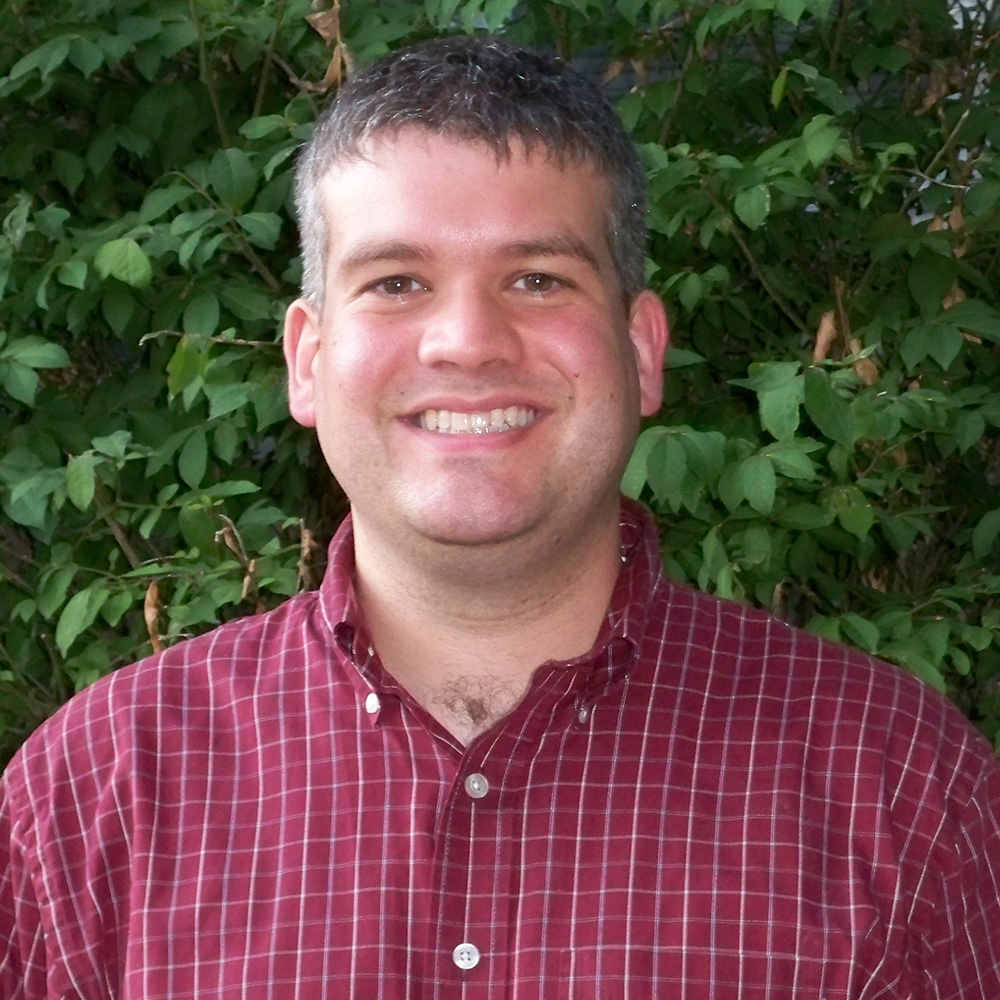
Paul Nolette is an attorney and Assistant Professor of Political Science at Marquette University. (Photo: Marquette University)
In terms of what to do about it, I think some of the things that should be considered are laws that encourage more transparency of AG activities. In a number of states, quite remarkably, lobbying rules apply only to legislators and the governor, but not to other state offices including the AG's office. So a lot of the disclosure requirements that apply to these other state-level actors don't apply to AGs, and that's something that probably needs to change. But I will say that there's so many incentives for AGs to take an activist role now that it's going to be hard to unwind, I think, so we might have to focus on things like disclosure and transparency to really know what's going on.
CURWOOD: Paul Nolette is a political science professor at Marquette University. His forthcoming book is called “Federalism on Trial: State Attorneys General and National Policy Making in Contemporary America”. Thanks for taking the time with us today, Professor.
NOLETTE: Thanks so much for having me, Steve.
Related links:
- Read the New York Times investigation into the AG energy alliance
- Documents from the New York Times’ investigation
- Paul Nolette teaches Political Science at Marquette University
CURWOOD: Coming up...a new way to have a green, green Christmas. Stay tuned to Living on Earth.
[CUTAWAY MUSIC:]
An Amusement Park’s Unruly Squirrels
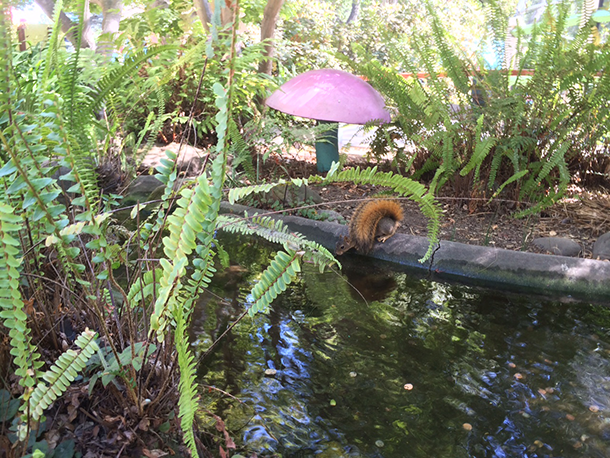
Squirrel spotted at the Fairyland watering hole. (Photo: Ike Sriskandarajah)
CURWOOD: It's Living on Earth. I'm Steve Curwood. Children’s Fairyland is a historic amusement park inside the nation's first wildlife refuge at Lake Merritt, surrounded by bustling downtown Oakland, Calif. This unique, urban utopia has attracted guests with its storybook charm since 1950 – it even inspired Walt Disney and his Disneyland. But recently, Fairyland has been overrun with aggressive fox squirrels, reddish rodents that are twice the size of the familiar grey squirrel - and seem to know no boundaries. Youth Radio’s Meaghan Baus has our story.
[MUSIC: FAIRYLAND THEME]
BAUS: Beatrix Potter’s Tale of Squirrel Nutkin opens like this.
STORYTELLER VOICE: “This is a tale about a tail—a tail that belonged to a little red squirrel, and his name was Nutkin. He had a brother called Twinkleberry, and a great many cousins: they lived in a wood at the edge of a lake.”

Looking out over Fairyland, surveying for squirrels. (Photo: Ike Sriskandarajah)
BAUS: Here in Oakland, in the wood, at the edge of Lake Merritt, is a place where fairy tales like Potter’s come to life. You can walk through the Alice in Wonderland maze, ride the mini choo-choo train, and visit that shoe where the old woman lived.
KID: It’s pretty amazing around here.
BAUS: There’s even a population of cuddly woodland creatures that call this park home.
KID: I saw a squirrel. [BAUS: Do you like the squirrels?] Yeah! [BAUS: They’re friendly and stuff?] [CHILD LAUGHS] Yeah!
BAUS: But for Fairyland employee, Crystal Griffen, the squirrels aren’t always welcome guests.
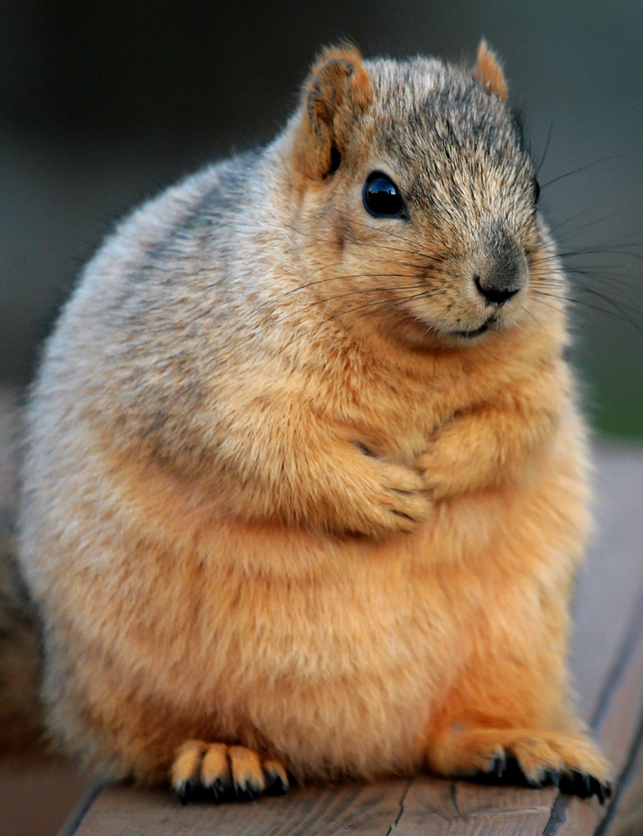
An overweight fox squirrel that can be found in Fairyland intimidating guests for their food. (Photo: James Marvin Phelps; Flickr CC BY-NC 2.0)
GRIFFEN: At Children’s Fairyland we have a lot of squirrels that come out because of the food that we feed them. I’ve never ever seen as many squirrels anywhere else but here at Children’s Fairyland in Oakland. [BAUS: Are they aggressive?] Yes, because they will go into someone’s stroller and get some food. They will come up to you when you’re eating. So you can’t eat at certain rides.
BAUS: According to one mother in the park, Malinda Derouen, they’ll go after adult targets too.
DEROUEN: I just kept backing up and the next thing I knew I looked away and this squirrel jumped on my pant leg and started crawling up me. And I like shook and got freaked out and the people around me were like “woah” and all these other parents couldn't believe it. They’re just very very aggressive here. They’re kind of chunky too.
BAUS: It’s more than just a case of spooked Moms and lost cookies. The executive director of Children’s Fairyland, CJ Hirschfeld, has assessed the damage, parkwide.
HIRSCHFIELD: They are destroying our irrigation lines on a weekly basis so that my team needs to come through and repair them on a weekly basis. Some people may not realize that - it sounds kind of awful - they eat the faces off of our - Mary Mary Quite Contrary - so that so that our art and restoration department is constantly having to do repairs on sets because they will eat through that.
BAUS: Over the last couple years, Hirschfield estimates that the squirrel scourge has gotten pricey.
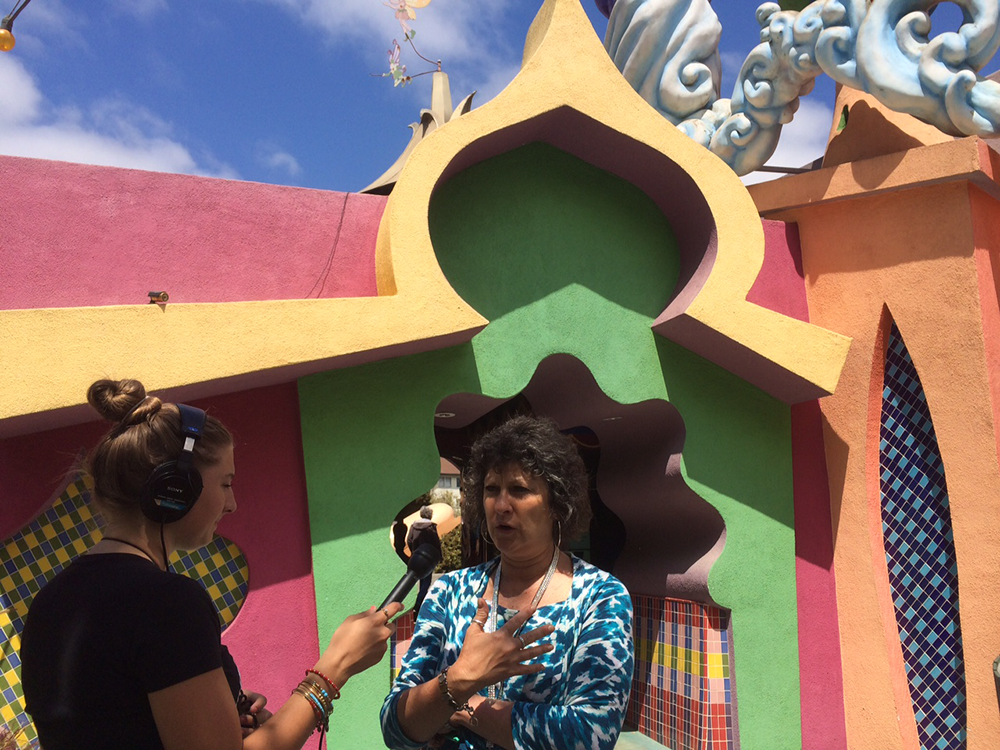
Meaghan Baus interviewing Park Director C.J. Hirshfield. (Photo: Ike Sriskandarajah)
HIRSCHFIELD: It’s definitely in the thousands, probably over time in the tens of thousands of dollars. You know this is a controversial issue. We love animals but we really feel we need to figure out a way to get a handle on this problem.
BAUS: So, she’s turned to the pros to help figure out a humane way to address the overpopulation. David James is an ecologist with the Alameda County Vector Control, with two decades of experience under his belt.
JAMES: What you’d have to do is live trap them - put the traps out when nobody is around and then once you’ve trapped them, there’s actually a little straightjacket. It’s like a little conical sleeve they run into it and you can trap them in there. And you can do the injections and release them.
BAUS: Some of the squirrels could be trapped and injected with a serum that stops them from reproducing, some could be exterminated. The other part of the plan is on the humans: locking down food sources, and training all park goers that even though it’s really fun, you can’t feed the squirrels.

David James of the Alameda County Vector Control considers using squirrel contraception. (Photo: Ike Sriskandarajah)
JAMES: then over a couple of years you will see a reduction, and hopefully that’s an acceptable level. Obviously we don’t want to get rid of all the squirrels, because people like squirrels, they are cute and have little fluffy tails.
BAUS: And they are cute. The fox squirrels, with their reddish fur and big cheeks, are kinda nice to see around.
[MUSIC: FAIRYLAND THEME]
BAUS: In Beatrix Potter’s story, squirrel Nutkin is trapped by an old owl. For the squirrels of Fairyland: straight-jacket traps by the Vector Control. Sometimes reality is stranger than fairytales.
For Living on Earth, I’m Meaghan Baus, in Oakland.
CURWOOD: That story was produced by Ike Sriskandarajah of Youth Radio.
[MUSIC: FAIRYLAND THEME]
Related links:
- Youth Radio
- Fairyland
Icy Roads Prescribed a Low-Sodium Diet
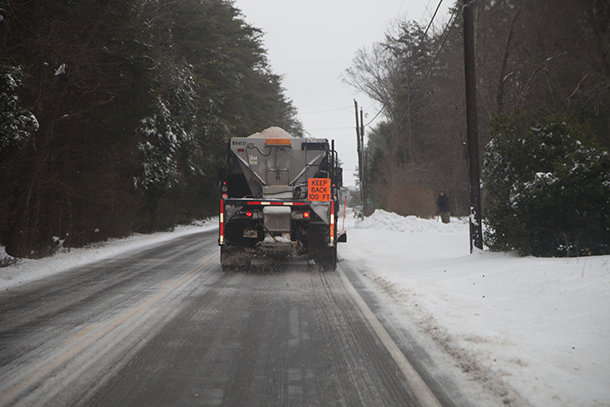
De-icing roads is crucial for keeping travelers safe, but commonly-used road salt can be harmful to the environment. (Photo: Virginia Department of Transportation; Flickr CC BY-NC-ND 2.0)
CURWOOD: Well, from sunny California we plunge into the kind of weather that many folks in more northerly parts of the US face in winter. Here’s this week’s note on emerging science from Jenni Doering.
DOERING: [SCIENCE NOTE THEME]
Winter in the north brings snow and ice – and tons of salt on roads. In Washington state, for example, road crews apply about four tons of salt per mile every winter – just for a single lane.
The salt certainly does the trick – it melts the ice, and makes it less likely to re-freeze – but there are both economic and environmental costs. Both the sodium and chloride ions in salt are toxic to plants and animals and accumulate in soils, streams, and groundwater. The ions also make cars rust and leach heavy metals from soils into the water supply. And salt on the roads attracts wildlife like deer and moose, causing deadly accidents. What’s more, sodium can get into drinking water and be harmful for people with high blood pressure.
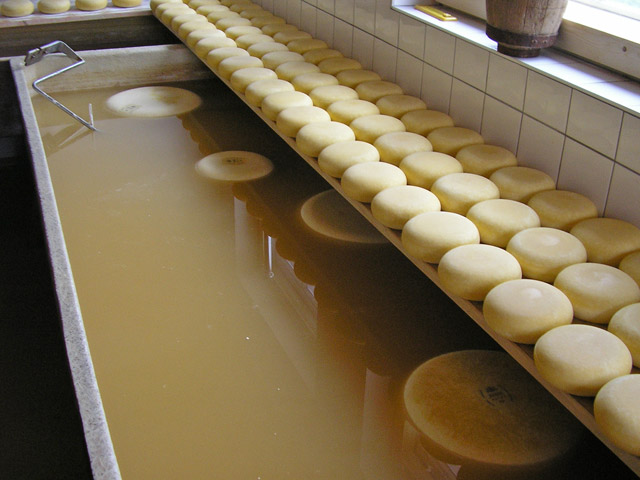
Cheesemaking involves soaking the cheese in brine. In Polk County, Wisconsin, road crews add waste brine to road salt to aid in de-icing. (Photo: Sint Smeding; Flickr CC BY-NC-ND 2.0)
Now, universities are researching ways to put icy roads on a low-sodium diet. As well as experimenting with dried-out peonies, dandelions, and grass, they’re proposing to substitute industrial byproducts derived from beets, sugar cane, barley, and cheese, for some of the salt. These waste products are produced during sugar refining and cheese-making. Using them to help in de-icing ensures that they don’t go to waste, and reduces costs for road clearing, for example, Polk county, Wisc. is able to get cheese brine for free from a local dairy. The scientists some of these additives actually help lower the melting point of ice more than salt alone – a clear advantage keeping roads clear and travelers safe.
That’s this week’s note on emerging science. For Living on Earth, I’m Jenni Doering.
[SCIENCE NOTE THEME]
Related links:
- What Happens to All the Salt We Dump on the Roads?
- Communities seek a substitute for road salt
- WSU researcher experiments with ‘green’ highway snow and ice control
- How Exactly Does Road Salt Cause Cars to Rust?
Renting Trees Keeps the Christmas Spirit Alive
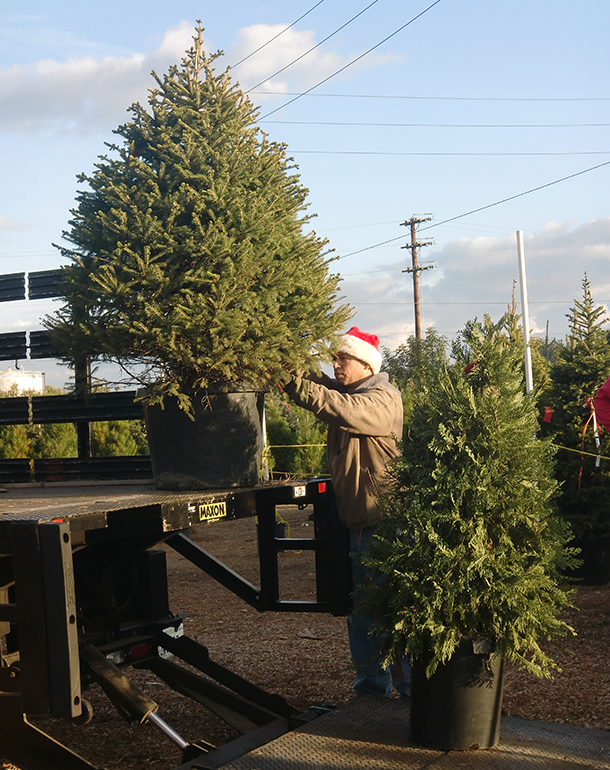
When they’re not adorning the living rooms of California residents, the living Christmas trees are kept in pots on a brownfield (previously industrial) site that serves as the company’s nursery. (Photo: Scott Martin)
CURWOOD: Some 90 million American households say it wouldn’t be Christmas without a tree, and though the majority of them are fake, about 33 million homes get a real tree. There’s an ongoing debate as to whether fake or real is better for the environment. Real trees are green and great-smelling compared to their plastic cousins, but cut trees are sometimes grown far from where they are sold, and they drop needles all over the floor. And, of course, cut trees are dying trees: they’re grown for seven to ten years, then chopped down, decorated for just a month and thrown away. Well, there’s an alternative to cutting down a seasonal pine or fir or spruce: rent a living Christmas tree. It’s the brainchild of Scotty Claus. Welcome to Living on Earth, Scotty.
MARTIN: Well, thank you for having me.
CURWOOD: So you call yourself Scotty Claus. What about the other folks at your company?
MARTIN: Oh, everyone at my company has a fun name whether it be Dean Jingle, Kristen Kringle, Tonya Twinkle, Justin Season, Greg Nog.
CURWOOD: Greg Nog? Justin Season? [LAUGHS] Now, what gave you this idea of renting Christmas trees?

The Colorado blue spruce is hardy and drought-tolerant, with strong branches that don’t droop under the weight of Christmas ornaments. It’s become a key species in The Living Christmas Company’s stock. But be careful! Those needles are sharp – so Scotty Claus recommends wearing gardening gloves while decorating the tree. (Photo: Tony Frates; Flickr CC BY-NC-SA 2.0)
MARTIN: It started when I was a kid, and there was no more fun you can have as a teenager delivering Christmas trees. Everybody's happy to see you. It really means that Christmas is begun in the house. So it was just a ton of fun and you can't complain about the tips. The problem was that the intense joy you felt was sort of curbed when a couple of weeks later I’d see that same tree that I struggled to get to the second storey of this person's house thrown out like the trash. I had been working there since I was 15 and thought "Why can't we do this with living trees?" I kept trying over the years, and I would give someone for Christmas an avocado tree to decorate or different varieties of trees and I kept trying until I felt like, hey, I've got a combination that will work and started a website called livingxmas.com and away we were.
CURWOOD: How exactly does your rent-a-Xmas-tree business work?
MARTIN: So, everything's online. You can choose your size and variety, and what our back end does is put in an efficient route, put 20, 30 trees on one truck, and reduce our footprint by delivering those trees more efficiently.
CURWOOD: How big are these trees?
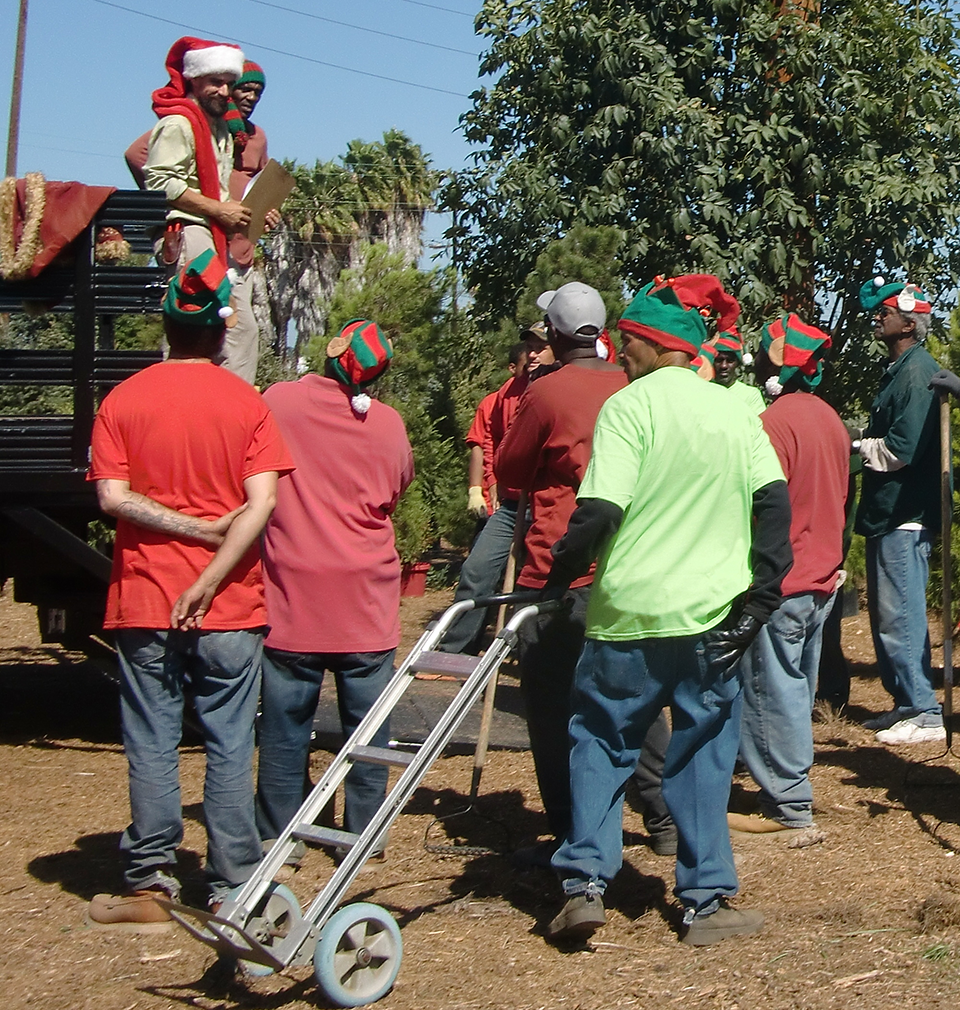
“Scotty Claus” talks with a group of his employees, or “elves.” The largest trees, which can be fifteen feet, require the teamwork of up to eight “elves” to move. (Photo: The Living Christmas Company)
MARTIN: We've got all varieties and sizes. We got them as small as a two to three foot, but, you know, we've got some large residences and institutions getting them all the way up to 15 feet.
CURWOOD: Fifteen feet...that's a lot of tree.
MARTIN: That's a lot of tree and a lot of roots to support that.
CURWOOD: So how do you get that, do you use a forklift. I mean, how do you get that thing around?
MARTIN: Each of the trucks already has a liftgate on it and then a pallet jack. The limiting factor is the weight. They can weigh over a ton. We have a certain gentleman that does pay for his second-storey delivery, and it takes about eight elves and we called it our "Free Willy" delivery because we have to put in the gurney to get up the stairs, but we're able to do it.
CURWOOD: Then what happens when the holidays are over?
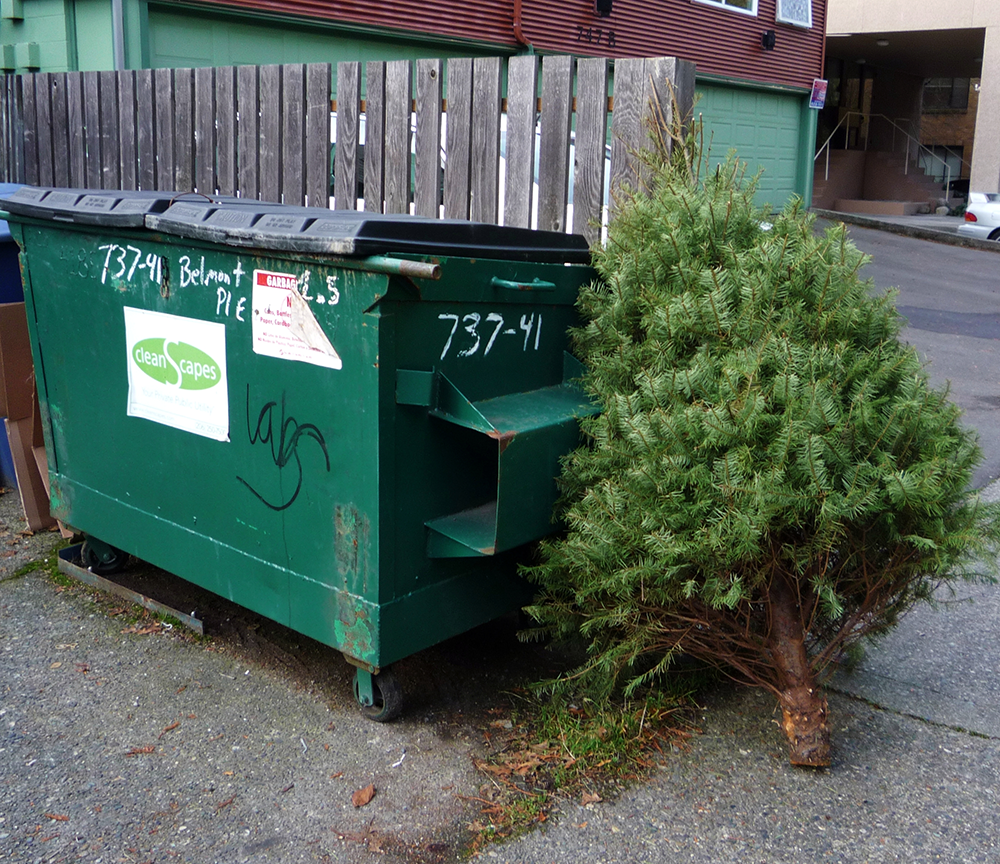
As a teenager who delivered Christmas trees to earn a little extra cash, Scott Martin hated seeing the same trees he’d delivered “thrown out like the trash. And I’d been working in a nursery since I was fifteen, and thought, why can’t we do this with living trees?” (Photo: sea turtle; Flickr CC BY-NC-ND 2.0)
MARTIN: So our elves pick them back up again and then they go to my lot. Currently we're able to use brownfields, so it's land that's been contaminated, or its future use makes it unsuitable for development. But our trees all have their own soil and are above ground, so we're able to return where nothing was going on into a forest in an urban area.
CURWOOD: And how true is it that when you fertilize these trees the rest of the year that you using, well, stuff from reindeer?
MARTIN: Yeah. [LAUGHS] Reindeer droppings have a special content to it that makes these magically grow faster, it’s true.
CURWOOD: Now, your business is there in California and to grow trees you need water, well, and water is not in great supply there, so how do you grow these trees?
MARTIN: What we've done...we've recently found that the Colorado Blue Spruce... it's one of the more traditional looking trees, looks like a traditional Noble Fir...holds ornaments great. In Southern California it didn't make the books as a tree that does really well here probably as defined by nurseries because it's such a slow-growing tree, but we found for our needs it's perfect that it's slow-growing and being slow-growing also doesn't require water in the same way that the other trees do. It's got a grey-green foliage so that also indicates is not quite as thirsty which makes it a perfect candidate for what we're doing and so we're slowly move our inventory towards different varieties of spruces.
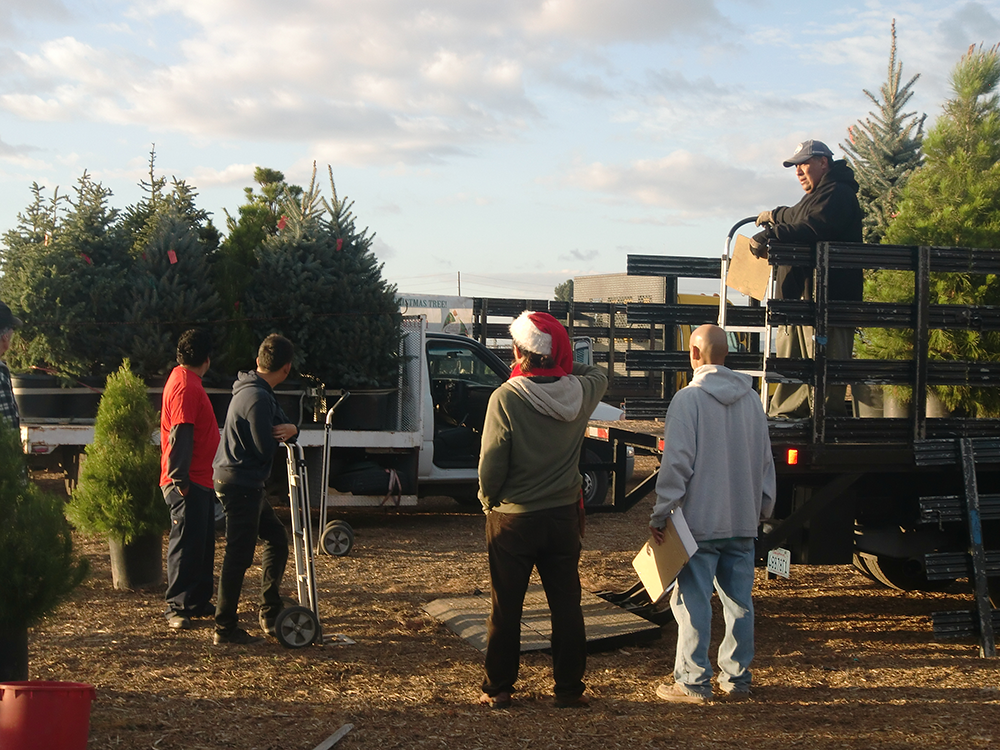
“Last year, we employed sixty people for the Christmas season [who] probably wouldn’t have had jobs otherwise,” Martin said. (Photo: The Living Christmas Company)
CURWOOD: What about somebody wants to buy a Fir or a Pine or something? What if they don't want the drought-resistant variety?
MARTIN: Yeah, so we inform our customers. A big part of this is setting expectations and informing them. We've chosen trees that grow locally in the area, either native or adaptive, and we still do offer two pine trees - an Aleppo Pine and a Monterey Pine - both are relatively adaptive to the California climate. They're not water thirsty, they just take more care and more water than the Spruce. There's a Cypress that we offer as well which is fairly drought tolerant. So just by nature of us choosing trees that grow in Southern California, that are native or adaptive, means they are going to need less water, and we've increased our number of Spruces to sort of push in that direction.
CURWOOD: Now, I wondering what kind of of hazard insurance you offer with the Blue Spruce since they're so prickly. I mean, you lean up against one and "ouch!"
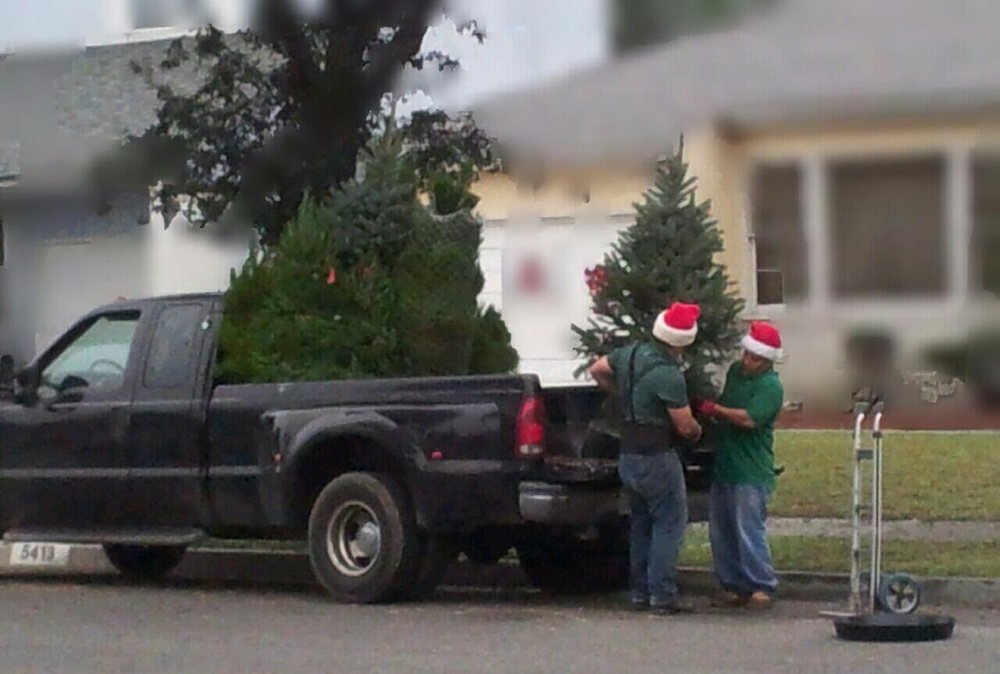
The Living Christmas Company packs 20 to 30 trees onto one truck and delivers them right to your door. (Photo: Scott Martin)
MARTIN: Yeah, Blue Spruce are a bit more prickly, but there's probably seven or eight varieties of the Colorado Blue Spruce that we've been using and trying to get little less sharp varieties into the mix, but we also recommend that you decorate with some gardening gloves and you'll be just fine.
CURWOOD: If I'm your client, Scotty, how likely is it that I could get the same tree year after year?
MARTIN: That's one of our most difficult programs, but most wonderful programs as well. With technology improving, we've able to geotag our trees so as they come in and someone's requested the same tree we're able to track its wherabouts in the nursery. Of course, we can't guarantee that same tree is going to be a premium tree for the following year, and so far the definition of a Christmas tree is still pretty perfectly conical and can't have gaping holes or dead spots, so in being a living tree we can't guarantee that, but most of our clients are pretty understanding of the flexibility required for having a living tree in their home.
CURWOOD: Now, how soon do you have to retire these rental trees?
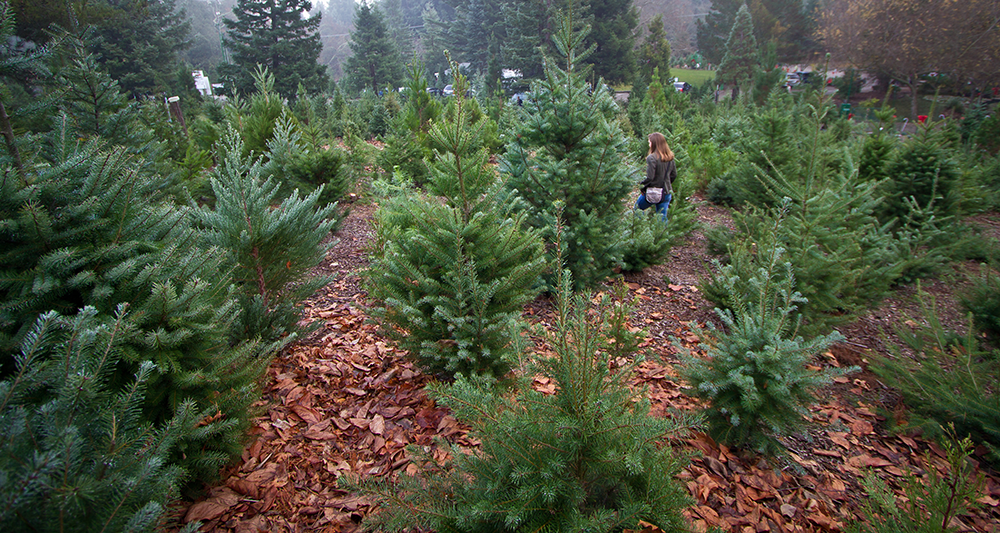
There are approximately 350 million Christmas trees growing on tree farms in the U.S. (Photo: anthony_goto; Flickr CC BY-NC-ND 2.0)
MARTIN: We don't have great numbers on that. We assume between five and 10 percent of the trees will not be with us for the following year just because of transportation costs and sometimes there's forgetfulness from our customers of, you know, how often they water. You're asking a lot of the tree to come inside a home. In southern California, it doesn't drop below maybe 40 degrees outside then it goes from 80 degrees inside then back out to cold temperatures it can be stressful, but so far we've, like I said, retained 90 percent of our trees from to year so we don't necessarily know the numbers on what the retirement rate is going to be in the future.
CURWOOD: Scotty, how much of a selling point is the green or environmental aspect of your business?
MARTIN: You know, it's a really strong part of it in that the stories I hear are those that have forgone getting a tree altogether because they're not comfortable cutting down a tree to bring it in their home and an artificial tree just doesn't say Christmas like the symbol they had when they were a kid. And so I've got people writing me e-mails or phone calls, and one year it was this woman in tears and said, "Since I moved out to LA, as a single woman I couldn't get a tree into my house on my own. I really don't believe in cutting down a tree. I'm just not going to buy a plastic tree and so this is the first time I've celebrated Christmas in 10 years,” and creating, recreating that connection is really special for us.
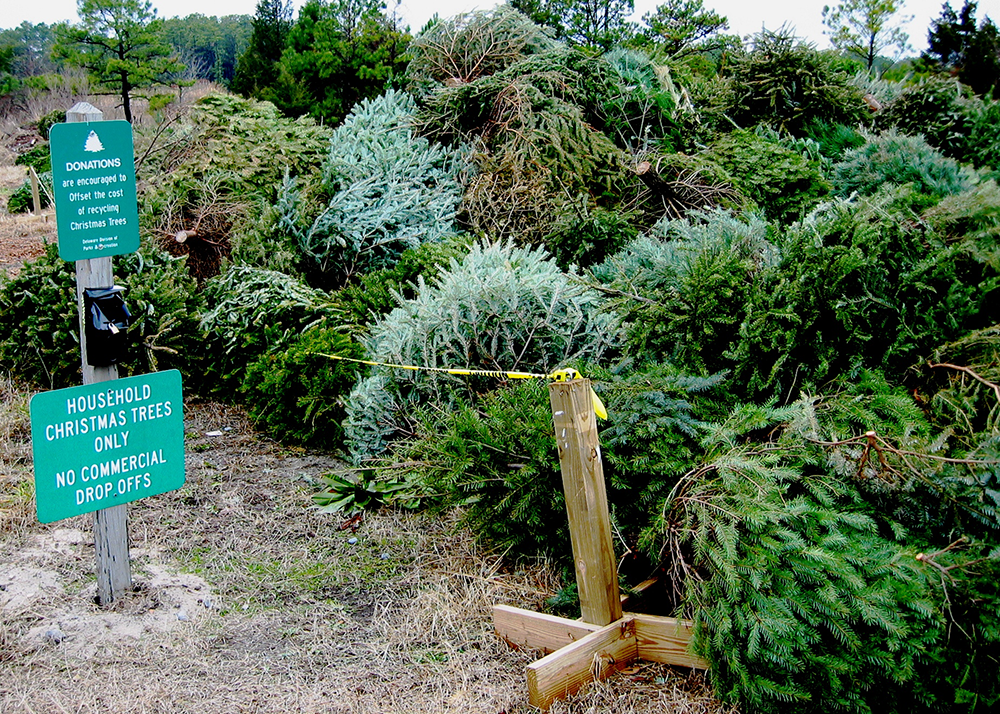
It’s estimated that at the end of the season, 9 of 10 cut Christmas trees are recycled in some way, yielding mulch, compost, and even habitat for fish! (Photo: Mike Mahaffie; Flickr CC BY-NC-ND 2.0)
MARTIN: What we talk about more than the environmental side of it is just what value do you have or what value do you want to teach your kids? Yes, we're saving a tree, but it's really about what's a symbol of a tree mean in the first place, and how important is it to you to have something living at the end of the year that goes on living into next year? When I look at these trees, you know, I can walk my lot, and I know that tree has sometimes been with two or three different families in part of different Christmas celebrations and so that's been able to go into that tree. I also know last year we employed 60 people in the Christmas season that probably wouldn't have had jobs otherwise, and so to me some of the special parts is that beauty of the tree that's going into it.
CURWOOD: I imagine you've developed a bit of a connection with these trees over time? You're naming them I think I heard?
MARTIN: Yeah. One of the things I enjoy most is going through and reading all the different names, you know, like Gangster Lean and Spruce Lee, Treesus Agustus, Little Baby Treesus, and reading what people name their trees is really one of the fun parts of the job.
CURWOOD: Oh, the customers name the trees.
MARTIN: The customers name the trees, yeah, that's...when you adopt a tree, you have to give it a Christmas name. And so the names they come up with are really wonderful.
CURWOOD: And so they must feel pretty strongly about getting that same tree back the next year?
MARTIN: It's a challenge when you raise that bar of of hope and expectation, but we do our best and try to keep a jolly disposition while doing it.
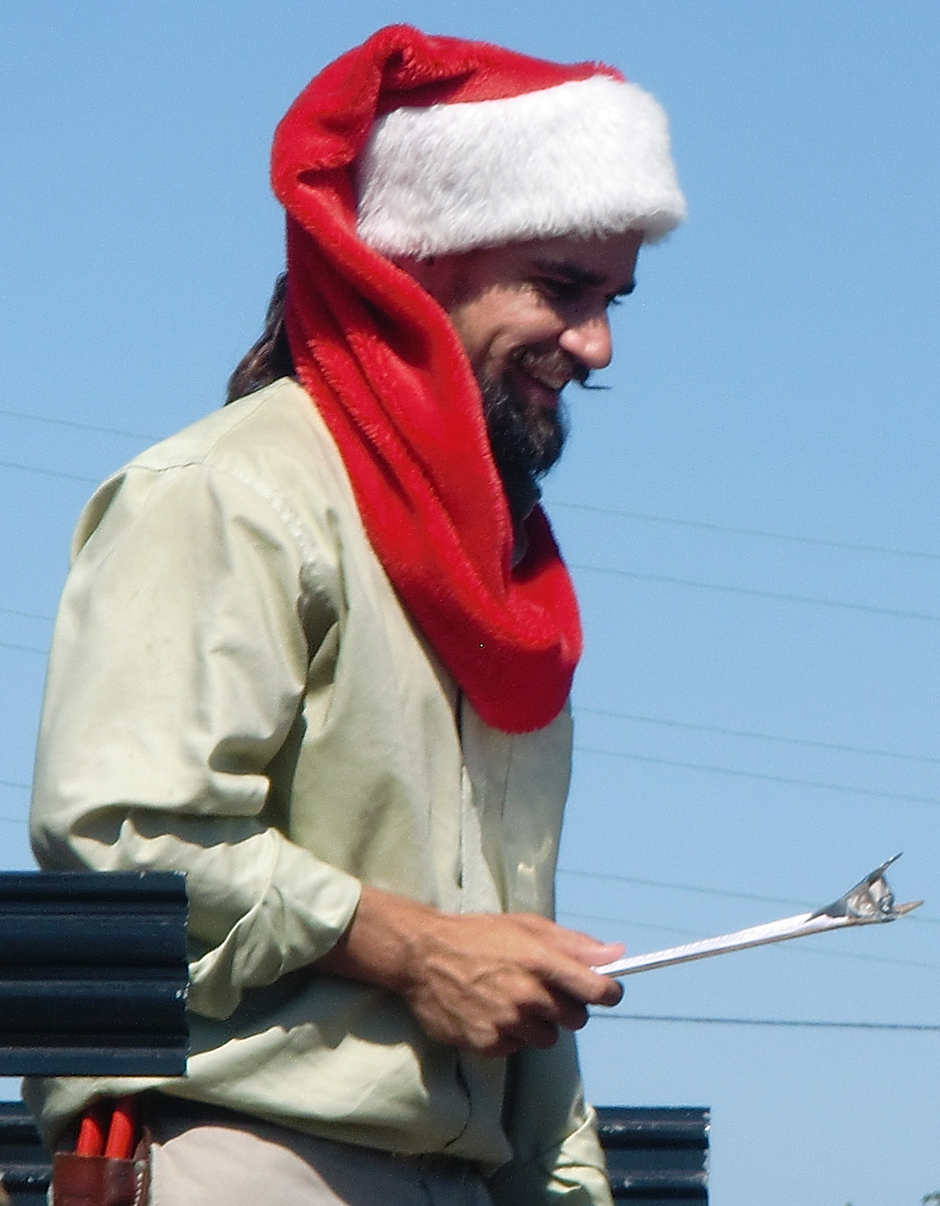
Scott Martin, aka “Scotty Claus,” is the founder of The Living Christmas Company, which rents potted Christmas trees to California residents and businesses. (Photo: The Living Christmas Company)
CURWOOD: But what if Wilbur isn't available this year?
MARTIN: We always give people the option of...if Fred can't make it maybe Frederica?...if Tiny Tim can't return back home, maybe Tim Senior can do the trick? So instead of a "no," or "your tree passed," it's an opportunity for a new beginning or a new relationship.
CURWOOD: Alright, before you go, tell me about the most fun installation that you had one of your rental trees?
MARTIN: I think one of the most touching ones was actually when I went to pick up the tree afterwards and the child sort of holding onto the tree, like hugging it, in tears like, you know, “can't we keep the tree, can it stay”, you know, sort of convincing her that the tree can come back next year. Having named it and taken care of it and watered it, the child really created a connection with the tree and it couldn't help but bring tears to my eyes just watching that unabashed love of the tree and had to convince him that the tree could come back next year.
CURWOOD: Scotty Claus, also known as Scott Martin for the rest of the year, is the founder of the Living Christmas Company, Christmas tree rental firm in California. Thanks so much for taking the time, Mr. Claus.
MARTIN: Absolutely. Thank you and Merry Christmas.
CURWOOD: Happy New Year!
Related links:
- The Living Christmas Company
- 10 Ways to reuse your Christmas tree
- How Green Is Your Artificial Christmas Tree? (New York Times)
[MUSIC: ]
CURWOOD: Coming up...celebrating the sound of silence...on the radio. That's just ahead on Living on Earth. Stay tuned.
ANNOUNCER: Funding for Living on Earth comes from United Technologies, a provider to the aerospace and building systems industries worldwide. UTC Building & Industrial Systems, provides building technologies and supplies container refrigeration systems that transport and preserve food and medicine with brands such as Otis, Carrier, Chubb, Edwards and Kidde. This is PRI, Public Radio International.
Beyond the Headlines
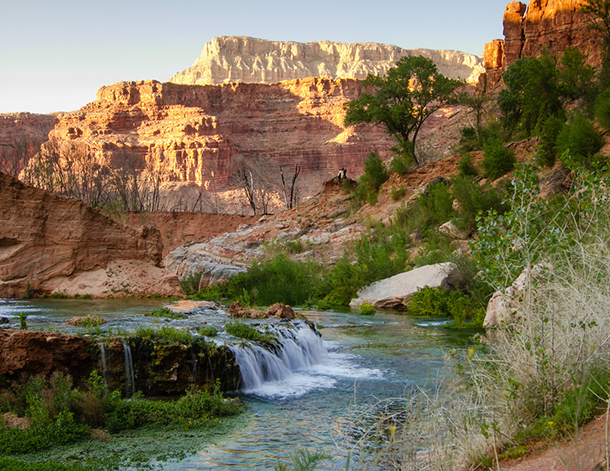
Reporter and environmental activist, Martin Litton, helped to block dam construction on the Grand Canyon River. (Photo: Sakeeb Sabakka; Flickr CC BY-NC-ND 2.0)
CURWOOD: It's Living on Earth. I'm Steve Curwood. We’ll head off for a look beyond the headlines with Peter Dykstra. He publishes Environmental Health News, EHN.org and the DailyClimate.org, and he’s on the line now from Conyers, Georgia. Hi, Peter, what caught your attention this week?
DYKSTRA: Well, hi, Steve, let’s start out with a tribute to a true American environmental hero, Martin Litton, who recently passed away at age 97. He was a giant, both literally and figuratively, and one of the few people anywhere who can say that they saved a river.
CURWOOD: And not just any river, Peter, but the Colorado, and also the Grand Canyon.
DYKSTRA: Right, Martin was arguably the last great founder of the modern American environmental movement, along with people like the late David Brower, and he and Brower battled against big dam projects in the Southwest. First an unsuccessful effort to stop the Glen Canyon Dam on the Colorado, but then they martialed the forces and political will to stop another dam that would have turned parts of the Grand Canyon into a lake. Martin was a reporter and editor, he was a World War II glider pilot, and he was a virtuoso river runner, taking wooden dories through the treacherous canyon, even once when he was 87-years-old. Litton went on to be a champion of protecting California’s redwood forests. I got to meet him once, and I knew I was talking to a hero. If there were an environmental Mount Rushmore, Martin Litton would be on it.
CURWOOD: Well, there must be a better way to honor environmental heroes than blowing up a mountain and carving people's heads into it.
DYKSTRA: You think of everything, Steve. Shall we move on?
CURWOOD: Please.

Many reputable science journals exist that peer-review study submissions and publish quality research. However, a fair amount of predatory journals like the Journal of Computational Intelligence and Electronic Systems preys on scientists. Groups like these accept poor-quality scientific papers, even non-scientific writing, conduct a fake peer-review and publish them for a sizeable fee. (Photo: Wiley Asia Blog; Flickr CC BY-NC-ND 2.0)
DYKSTRA: Well here’s a cautionary tale from the world of science – not environmental science, strictly speaking - but a big lesson just the same. In recent years, there’s been a spate of online, for-profit, dubious scientific journals that have been accused of publishing almost anything as a scholarly work – as long as there’s a fee. There’s a rather clever engineer named Alex Smolyanitsky who set up a trap, sending a paper of absolute gibberish, authored by obviously fake authors from obviously fake universities, and guess what happened?
CURWOOD: One of these journals published it?
DYKSTRA: No, TWO of these journals published it. An online artificial intelligence journal, and an online nanoscience journal. The fake authors were two characters from the Simpsons, Maggie Simpson and the schoolteacher, Mrs. Edna Krabappel, along with a Mr. Kim Jong Fun. That didn’t raise any eyebrows with these journals. The three were said to be professors at fake universities – and that didn’t raise any eyebrows. And the publication itself made no sense, because the real author was a random text generation computer program, and that didn’t catch the eye of these journals, either. The fake authors were notified that their fake paper passed peer review and was published. They also got an invoice for $459, presumably to cover the costs of the fake peer review.
CURWOOD: Sounds like science fiction to me. What should the public make of this?
DYKSTRA: Well, it’s a scam, it’s not science. Make sure you’re skeptical and ask questions. You can also go to websites like retractionwatch, which monitors scientific integrity in published papers and journals. There are not only financial science scams like this one apparently is, but there’s also ideological abuse of science, my favorite example being “The Oregon Petition Project,” which denies the existence of climate change and drew thousands of signers. The sponsors were not very picky on which scientists signed on, however, and among so-called distinguished scientists listed on this early climate denial petition were the Spice Girls and the cast of the TV show M*A*S*H.
CURWOOD: OK, so I guess we need to be careful out there. Hey, take us back for a look at environmental history now please.

A sketch of the Ted Kaczynski (aka Unabomber) as commissioned and released by the FBI. (Photo: US Government; Public Domain)
DYKSTRA: I’ve got a sad and sorry story for you and it has a quirky ending. It was 20 years ago this past week that a package bomb blew up in a home in New Jersey, killing its recipient, Thomas Mosser. He was an advertising executive whose firm had some not so green clients. Mosser became the third fatal victim of the Unabomber. Dozens more were wounded or maimed by a series of bombings that ran from the late '70s to the mid '90s, until Ted Kaczynski, a mathematician turned madman, was arrested for the bombings.
CURWOOD: So Kaczynski picked his targets because he thought they were harming the environment?
DYKSTRA: Yeah. But as befits a madman, those connections were pretty remote at best. The Unabomber’s still locked up, and it’s still an awful story, but here’s the quirky connection: as famous as that house on a cul-de-sac in North Caldwell, New Jersey became, some TV producers took note of the house next door, which became the fictional TV home of another violent guy, Tony Soprano.
CURWOOD: So, I guess both truth and fiction can be pretty strange.
DYKSTRA: I guess so.
CURWOOD: Peter Dykstra is the publisher of Environmental Health News, that’s EHN.org and the DailyClimate.org. Thanks so much, Peter.
DYKSTRA: Thanks a lot, Steve, we’ll talk to you soon.
CURWOOD: And there’s more on these stories at our website, LOE.org.
Related links:
- Martin Litton helped launch the modern environmental movement, blocked Grand Canyon Dams.
- Exposure of two predatory science journals
- Retraction Watch exposes failings of the science industry, like falsified research and predatory journals.
- The Oregon Petition Project
- Read about Thomas Mosser, his clientele and relation to the Unabomber.
- More on Ted Kaczynski
Quiet Places Around the World
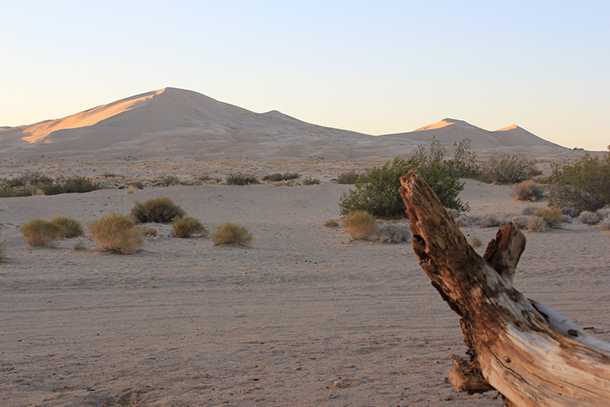
The Kelso sand dunes of the Mojave Desert. (Photo: Courtesy of Trevor Cox)
[MUMBLED TUNE]
CURWOOD: Now, that sounds something like Rossini’s William Tell Overture played, well, somewhat out of tune. But it’s actually highway rumble strips in Lancaster, California, recorded by Trevor Cox as part of his research for “The Sound Book”. Trevor Cox is a Professor of Acoustic Engineering at the University of Salford in England, and he travels the world in search of beautiful or surprising sounds. But for one chapter, he takes off his headphones and explores silence. Trevor Cox joins us now from the UK. Welcome to Living on Earth.
COX: Hi, there.
CURWOOD: So, you're out in the Mojave, and you're listening. How do you feel in this experience?
COX: Well, it was kind of an odd experience because we had gone there to hear booming sand dunes. We had to go in the middle of the summer, in the middle of June, so it was very hot, and we were actually high up on Kelso Dunes, which is also quite hard to walk up. Even when you just walk on it, you can actually hear, well, it sounds a lot like someone playing the tuba badly as you walk along, so you can actually hear your footsteps making these weird sort of baap, baap, baap, baap..
[SOUNDS RECORDED ON THE DUNES].
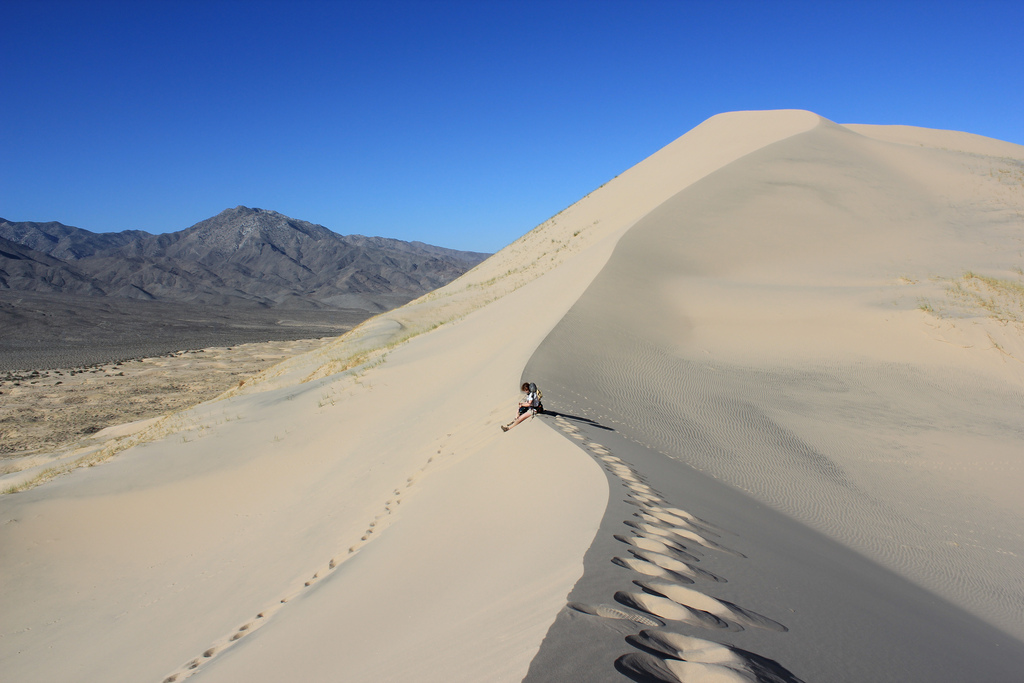
Recording the “droning sand dunes” in the Mojave Desert’s Kelso Dunes. These are not the only dunes that make this noise, but it only occurs when grains of sand are the same size and tumble over each other at the same rate. (Photo: Courtesy of Trevor Cox)
COX: So, I suppose one of my feelings was vague exhaustion and heat, but beyond that I thought of it as a beautiful silence because it really did seem very natural for a desert not to have any sound. I mean, if I had been somewhere...if I had gone to the normal countryside and heard silence, I might have felt, well, where's the wildlife…it all sounds a bit dead. But in the desert, you don't expect to hear anything, so it seemed quite natural.
CURWOOD: So, the reason you went to the desert in the first place was to capture very big sound, that sound of the famous singing sands. Let's hear that.
[BOOMING SANDS SOUND]
CURWOOD: It almost sounds like the sand is alive is some way. Tell us about the moment when you first heard the sound in person.
COX: Yeah, you talked about the dune sounding alive. Well, it feels alive because to create it, if there's no spontaneous avalanche happening, what you need to do is to sit on your backside and create an avalalanche yourself. So, when you hear that sound, what I think about is not just the sound, but the memories of the whole dune shaking around me as the whole lot of sand went down underneath me. There's a lot of debate of about why it particularly makes that sound, but it's all to do with the friction of the grains as they move past each other, with grains all the same size, they slip over each other at exactly the same rate.
CURWOOD: Now, you have a place that's made to be completely silent at the University of Salford, an anechoic chamber. Tell us about the chamber and how it can keep out all the noise.
COX: It's a very strange place to enter into. You have to go through these very thick heavy acoustic doors, which are there to shut out the outside world. When you arrive in it, in ours you have a trampoline wire floor you stand on, which is a bit disconcerting, and then all around you're surrounded by these big gray wedges on the floor, on the walls, on the ceiling. Everything you say just disappears into the wall and vanishes so when you talk it sounds odd because it's quite a lot of effort and everything sounds a bit muffled. I was going to say the nearest description is if you're in a plane and you know your ears need to pop, and then if you stop for a moment, you notice you can't hear any outside sounds because you're inside - essentially you're inside a room within a room - and it's all mounted on springs to stop any vibration from getting into it, so it's an incredibly quiet space.

Trevor Cox stands in the University of Salford’s anechoic chamber. (Photo: Courtesy of Trevor Cox)
CURWOOD: So, let's get an idea of what it sounds like to be in there. We're listening to a little bit of you playing Claude Debussy's Syrinx on your saxophone in the chamber.
[SAX INSTRUMENTAL]
CURWOOD: So now why does that sound so different than in the concert hall or someplace that's not so dead?
COX: Well, normally in a concert hall, whenever you stop in there, the sound lingers in the room for a little while. In a concert hall, it lasts probably a couple of seconds before dying away, and even, I'm talking to you from a little office here, it will last maybe half a second before dying away, whereas in that place there's nothing, there's no reflections off the walls, there's no reflections off the ceiling, or a floor to make the sound linger, so everything just dies immediately. So it's very unnatural. As a player, one of the things I noticed is my vibrato doesn't very good and all the little details of my playing which aren't quite right are really really clear. So, musicians don't really like playing in that because there's no support from the room, it feels like really hard work, and all your mistakes are kind of highlighted.
CURWOOD: That's right. You know, every vocalist's trick for performance is a little echo, a little reverb on there. It makes them sound sweeter and better.
COX: Yeah, and even if we're not professional vocalists, we like to go into the bathroom and sing because we know the supporting effect of the tiled walls make it sound better.
CURWOOD: Let's play another clip from the chamber. This one is of you firing a starting pistol.
[SOUND OF A CLICK]
CURWOOD: I'm going to play that again because I can barely hear that.
[SOUND OF A CLICK]
CURWOOD: Now, we're going to play you firing that starting pistol out in the real world.
[SOUND OF A GUNSHOT]
CURWOOD: So this is really a surprising example of how much the chamber can take a huge sound like a gunshot and turn it into a helpless little pop.
COX: Yeah, it's just a little click isn't it? Yeah, because we're used to hearing a gun, I suppose we're used to hearing a lot of Hollywood guns for one thing aren't we? Which have got lots of extra reverberation on that, lots of room effect to make them sound powerful. Whereas, in reality, the gun itself really just makes a little click. When I made that recording, I actually went back and thought, "No, that can't be right. I have to do it again," because I couldn't quite believe how quiet and how pathetic it was really.
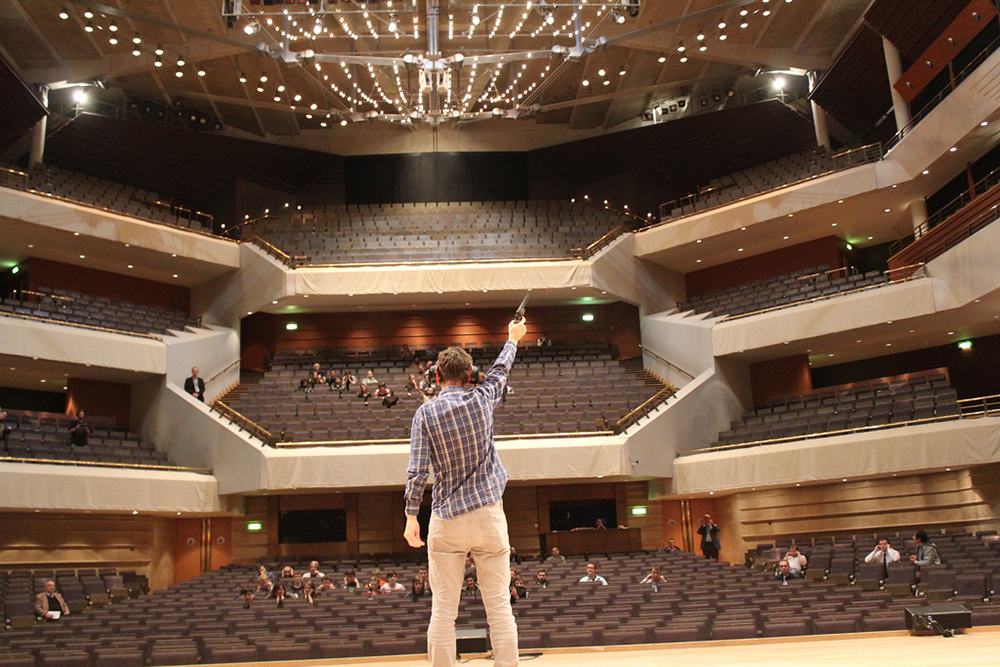
Professor Cox fires a starting pistol in Bridgewater Hall in Manchester for a class of University of Salford students. (Photo: Courtesy of Trevor Cox)
CURWOOD: Unless, of course, you're a spy and you want a silencer on that gun, doing somebody in.
COX: I guess so. I suppose it's an ideal place for assassination. I never really thought of that before.
CURWOOD: What did you take away from thinking about and visiting the silent places like the Mojave?
COX: Well, it made me think about how there's different kinds of silences. I mean, strictly speaking, silence is an absence of sound. But you don't usually hear that, and the reason is that actually you make internal noises. So, if you go into an anechoic chamber like the one we have at Salford, what you'll hear is actually the sound of blood moving in your head, or you might here some firings on your auditory nerves. So you don't tend to find complete silence, that's one of the surprises, but if you travel around you find that for a lot of people, peace and quiet is not about getting into complete silence places which is after all, rather desolate, but actually places where manmade noise is absent. What you then have is a lot of natural sound.
CURWOOD: Now, the Campaign for Rural England is one group that's working to identify the most tranquil places in England and had you record a few of them. Let's listen to a little bit of what they call the most tranquil place.
[SILENCE, WITH SOUND OF TAPE HISS]
CURWOOD: Well, it's not completely quiet, what are we hearing here exactly?
COX: Well, the hissing you're hearing is actually the electrical noise on my recorder. And I had some recording equipment, I tried to record it. But I had to turn the gain up on my amplifier as much as I could and what you'll hear is a little bit of electrical hissing. It's quite hard to get to, so I didn't have the quietest of recording gear because it's tranquil, it's away from manmade places. It's not near any roads. And, in fact, to get there, I had to bike on the road, mountain bike across the country, and then go for a hike to get to the actual spot they identified. So it's quite a long palaver to get to the place. And there, there really wasn't anything to hear. I mean, it was quite, quite surprising. I was expecting to maybe hear some nature, but it really was almost completely silent. There was occasional bird sound, but it was very rare.
CURWOOD: And Trevor, where is this place?
COX: Well, it's kind of kept a little bit secret. If you look at a map of Britain, it's about about three-quarters of the way up, so it's right at the corner of England and Scotland and Northumberland And it's quite a funny place when you go visit it, because when you go towards it, what you'll actually find is, it's right near a Royal Air Force firing range. And one of the reasons it's very quiet is because it's the Air Force training. There's nothing else around because it's normally used for shooting practice. But if you turn up there on the day they're all there practicing, I can assure you it is anything but tranquil.
CURWOOD: Now, what other kinds of attempts to protect these quiet places are already in place, legislatively or otherwise?
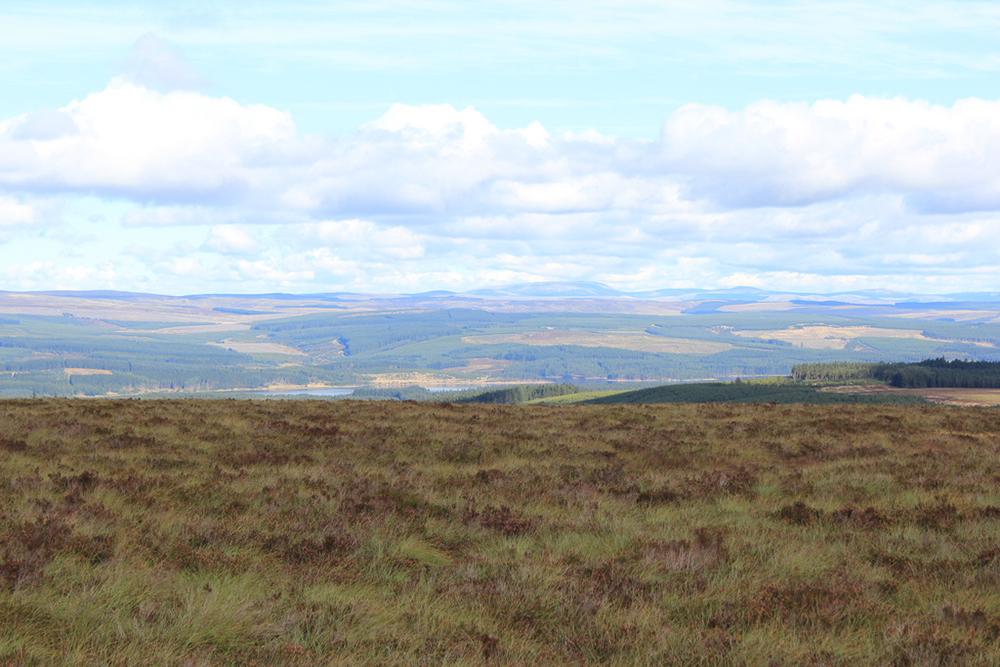
A view from the most tranquil place in Britain, near the border of England and Scotland. (Photo: Courtesy of Trevor Cox)
COX: Within Europe, they actually have a directive to say that countries have to identify quiet areas and identify actions they will take to preserve them. Now, I know across America, the National Park Service look to try and preserve soundscapes, so not just preserve the landscape - what you can see - but also preserve the sounds that you can hear in places. So there's quite a lot of campaign groups and regulation trying to deal with this problem of noise. It's quite a difficult balance to strive because most human activity makes noise and because we don't want to stop people doing what they want to do.
CURWOOD: Now, how are silent or at the very least quiet places at risk?
COX: Well, they're at risk in the cities and out in the countryside, so out in the countryside we have problems like aircraft overflying. In cities, we have a problem that the city itself on average isn't really getting very much louder, but what's happening is we're losing little quiet pockets, little places where you can get away from the noise.
CURWOOD: What about aircraft...it seems that any time I'm in the wilderness someplace that seems far and away and early in the morning, extremely quiet...then the planes.
[PLANES FLYING OVERHEAD]
COX: Yes, the thing is, engineers are doing quite well at making planes and cars quieter, but we're flying more, we're driving more. So what's happening is individual planes and cars are getting quieter as technology gets better, but there's many more people using them. Especially in a plane, because you're high up in the air, it pollutes a very large area, so, yeah, there is a problem in lots of countries about the noise from aircraft. At the moment in the UK, they're debating where to build another runway near London, and all discussions are nearly all about the noise problems this creates.
CURWOOD: Well, why are these quiet places so important and why should be concerned about losing them?
COX: There's lots of evidence that noise causes us problems. We know that noise getting in the way of sleep is a problem, so we know that it's important that we can get away from noise, and psychologically that's important for us as well. There's been a variety of scientific studies into the importance of having quiet refuges, and for example, there was a study in Sweden, which showed that if you lived on a busy road then that was OK provided that one side of your house backed onto somewhere quiet because that gives you somewhere in your house to get away from the noise for some of the time. So provided people can get away from the noise of the city and they're not stuck listing to noise all time, they seem to find it much less annoying.
CURWOOD: Now, what about being around people who are constantly chattering?
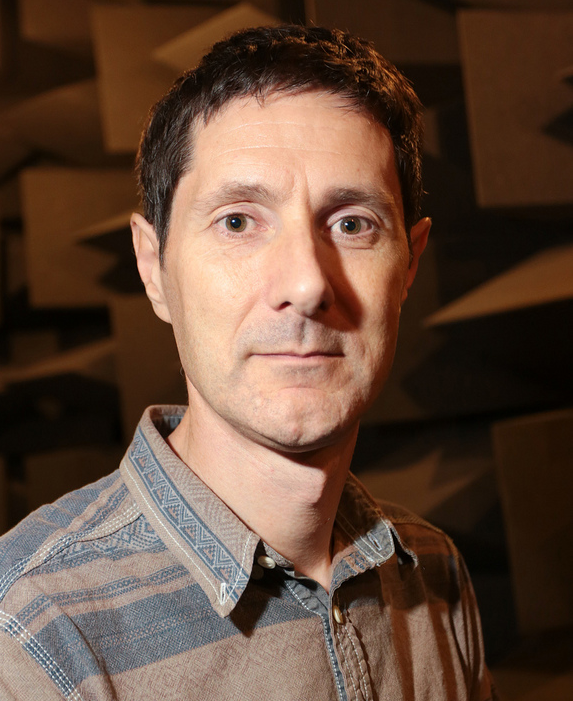
Trevor Cox is a professor of acoustic engineering at the University of Salford. (Photo: Courtesy of Trevor Cox)
COX: Well, I think it's quite interesting because there's something quite pleasurable about chattering provided it's not too much, because we're social animals, we do very well because we live in a society where we corporate with each other. So, actually the sound of gentle babble you get as you sit in the corner of a cafe, I suspect is rather good for you.
[SOUNDS OF CHATTER IN A QUIET CAFÉ]
CURWOOD: So what got you into sound?
COX: Well, I did physics originally. I was good at science as a kid and I was also a musician. I played the clarinet when I was younger, and so it seemed a natural way of combining two things, my interest in music and my interest in science.
CURWOOD: And so, all those hours sitting with a clarinet have paid off?
COX: Well, I don't know if they paid off. I'm not the greatest of musicians, but they certainly inspired an interest that lasted the rest of my adult life.
CURWOOD: Trevor Cox is a Professor of Acoustic Engineering at the University of Salford in the UK. Thanks so much for joining us.
COX: Thanks very much.
[SAXPHONE CROONING]
Related links:
- The Sound Book by Professor Trevor Cox
- Trevor Cox’s sound blog
- Cox’s “sound tourism” blog highlights strange and interesting sounds all over the world.
CURWOOD: Living on Earth is produced by the World Media Foundation. Naomi Arenberg, Bobby Bascomb, Emmett Fitzgerald, Helen Palmer, Adelaide Chen, Jenni Doering, Lauren Hinkel, Jake Lucas, and Jennifer Marquis are all part of our team. Our show was engineered by James Curwood, with help from Karlyn Daigle. Alison Lirish Dean composed our themes. You can find us anytime at LOE.org - and like us on our Facebook page - it's PRI's Living on Earth. And we tweet from @LivingOnEarth. I'm Steve Curwood. Thanks for listening.
ANNOUNCER1: Funding for Living On Earth comes from the Grantham Foundation for the protection of the environment, supporting strategic communications and collaboration in solving the world’s most pressing environmental problems. The Kendeda Fund, furthering the values that contribute to a healthy planet, and Gilman Ordway for coverage of conservation and environmental change. Living on Earth is also supported by Stonyfield Farm, makers of organic yogurt, smoothies and more. www.stonyfield.com.
ANNOUNCER2: PRI. Public Radio International.
Living on Earth wants to hear from you!
Living on Earth
62 Calef Highway, Suite 212
Lee, NH 03861
Telephone: 617-287-4121
E-mail: comments@loe.org
Newsletter [Click here]
Donate to Living on Earth!
Living on Earth is an independent media program and relies entirely on contributions from listeners and institutions supporting public service. Please donate now to preserve an independent environmental voice.
NewsletterLiving on Earth offers a weekly delivery of the show's rundown to your mailbox. Sign up for our newsletter today!
 Sailors For The Sea: Be the change you want to sea.
Sailors For The Sea: Be the change you want to sea.
 The Grantham Foundation for the Protection of the Environment: Committed to protecting and improving the health of the global environment.
The Grantham Foundation for the Protection of the Environment: Committed to protecting and improving the health of the global environment.
 Contribute to Living on Earth and receive, as our gift to you, an archival print of one of Mark Seth Lender's extraordinary wildlife photographs. Follow the link to see Mark's current collection of photographs.
Contribute to Living on Earth and receive, as our gift to you, an archival print of one of Mark Seth Lender's extraordinary wildlife photographs. Follow the link to see Mark's current collection of photographs.
 Buy a signed copy of Mark Seth Lender's book Smeagull the Seagull & support Living on Earth
Buy a signed copy of Mark Seth Lender's book Smeagull the Seagull & support Living on Earth

